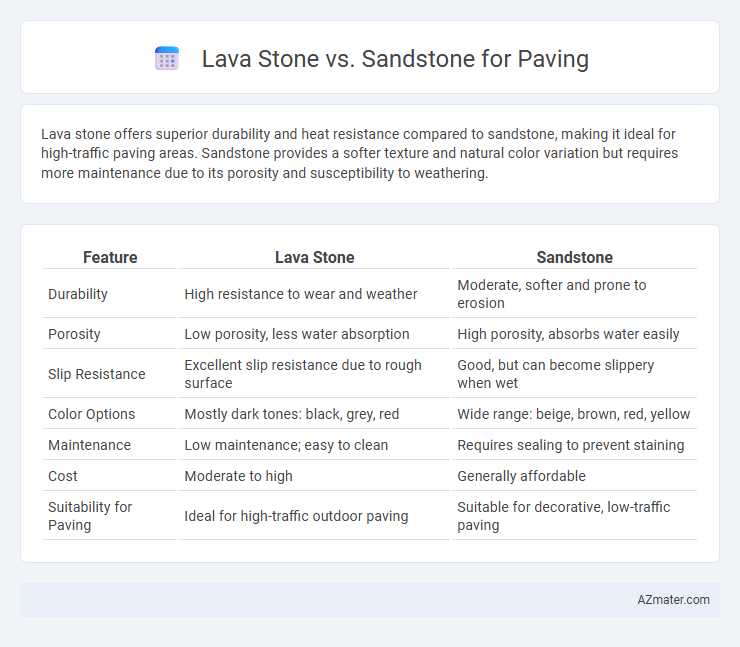Lava stone offers superior durability and heat resistance compared to sandstone, making it ideal for high-traffic paving areas. Sandstone provides a softer texture and natural color variation but requires more maintenance due to its porosity and susceptibility to weathering.
Table of Comparison
| Feature | Lava Stone | Sandstone |
|---|---|---|
| Durability | High resistance to wear and weather | Moderate, softer and prone to erosion |
| Porosity | Low porosity, less water absorption | High porosity, absorbs water easily |
| Slip Resistance | Excellent slip resistance due to rough surface | Good, but can become slippery when wet |
| Color Options | Mostly dark tones: black, grey, red | Wide range: beige, brown, red, yellow |
| Maintenance | Low maintenance; easy to clean | Requires sealing to prevent staining |
| Cost | Moderate to high | Generally affordable |
| Suitability for Paving | Ideal for high-traffic outdoor paving | Suitable for decorative, low-traffic paving |
Introduction to Lava Stone and Sandstone
Lava stone, formed from volcanic activity, boasts a porous texture and exceptional durability, making it ideal for outdoor paving that requires slip resistance and weather resilience. Sandstone, a sedimentary rock composed mainly of quartz and feldspar, offers a softer surface with natural earthy tones and excellent workability for decorative paving projects. Both materials provide unique aesthetic and functional qualities, with lava stone favored for rugged environments and sandstone prized for its warm appearance and versatility.
Physical Properties Comparison
Lava stone offers high durability and excellent heat resistance, making it ideal for outdoor paving with superior slip resistance due to its porous texture. Sandstone, characterized by its fine grain and softer composition, provides moderate strength and weather resistance but is more prone to wear and erosion over time. The hardness of lava stone typically exceeds that of sandstone, ensuring longer-lasting pavement with minimal maintenance in high-traffic areas.
Aesthetic Differences
Lava stone offers a unique volcanic texture with dark gray to black hues, creating a striking, modern look for paving projects. Sandstone features warm earth tones ranging from beige to reddish-brown, providing a classic, rustic appearance that enhances natural landscapes. The choice between lava stone and sandstone significantly influences the visual impact, with lava stone emphasizing bold contrast and sandstone promoting subtle, natural harmony.
Durability and Weather Resistance
Lava stone exhibits exceptional durability and superior weather resistance compared to sandstone, making it ideal for harsh outdoor paving conditions. Its volcanic origin ensures a dense, hard surface that resists erosion, freeze-thaw cycles, and UV degradation effectively. Sandstone, while aesthetically pleasing and easier to work with, tends to be more porous and susceptible to weather-induced wear and staining over time.
Slip Resistance and Safety
Lava stone offers superior slip resistance for paving due to its naturally rough and porous surface, making it a safer option for wet or humid environments. Sandstone, while aesthetically pleasing, tends to have a smoother texture that can become slippery when wet, posing potential safety risks. Choosing lava stone enhances walkway safety by reducing slip hazards in both residential and commercial outdoor spaces.
Installation Process and Complexity
Lava stone paving requires precise cutting and leveling due to its dense, porous texture, making installation moderately complex compared to sandstone. Sandstone offers easier handling and flexibility during installation because of its uniform grain and softer composition, reducing labor time and effort. Both materials demand professional expertise for optimal alignment and drainage management, but lava stone typically involves higher costs and longer installation duration due to its hardness and weight.
Maintenance and Cleaning Requirements
Lava stone offers exceptional durability and requires minimal maintenance, needing only occasional sweeping and water rinsing to remove dirt and debris. Sandstone, being more porous, demands regular sealing to prevent staining and water absorption, alongside gentle cleaning methods to avoid surface erosion. Both materials benefit from prompt removal of spills to maintain appearance, but lava stone generally provides a more low-maintenance option for paving applications.
Cost Analysis: Lava Stone vs Sandstone
Lava stone typically costs more than sandstone due to its durability and unique volcanic composition, averaging $12 to $20 per square foot compared to sandstone's $8 to $15. Installation expenses for lava stone can be higher because of its irregular shapes and density, requiring specialized labor, whereas sandstone's softer texture allows for easier cutting and faster installation. Maintenance costs also favor sandstone since its porous nature demands more frequent sealing, while lava stone's dense structure resists weathering and reduces long-term upkeep expenditures.
Environmental Impact and Sustainability
Lava stone offers a highly sustainable option for paving due to its natural abundance, durability, and minimal processing requirements, which reduces carbon emissions compared to sandstone. Sandstone, although renewable, often involves intensive quarrying that can lead to habitat disruption and higher environmental degradation. Choosing lava stone supports reduced environmental impact through lower energy consumption and longer lifespan, making it a preferred eco-friendly paving material.
Best Use Cases for Each Material
Lava stone offers exceptional durability and heat resistance, making it ideal for high-traffic outdoor areas, patios, and pathways exposed to intense sunlight or fire features. Sandstone provides a softer, more natural aesthetic with excellent slip resistance, perfect for garden paths, pool surrounds, and decorative walkways where comfort and appearance are prioritized. Choose lava stone for longevity in harsh conditions and sandstone for its warm, textured appeal in residential landscaping.

Infographic: Lava stone vs Sandstone for Paving
 azmater.com
azmater.com